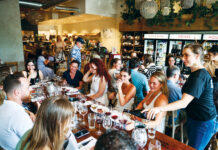
Jennifer Hoffman, an astronomy professor at the University of Denver and director of the Chamberlin Observatory, wants you to look up. She studies exploding stars and the stories starlight can tell, and she’s passionate about helping others connect with the cosmos. Whether you’re using a telescope, binoculars, or a phone app, Hoffman believes you deserve a chance to stare into space, wonder, and feel small—but empowered—beneath the stars. Curious about how to get started stargazing, what’s behind this year’s northern lights, and how Hoffman helps others find their place in the universe, we met up for a chat at the Chamberlin Observatory. Here’s what she had to say.
Cosmic calling: “The Challenger explosion was a catalyzing event for me. Watching it happen in real time traumatized me—and paradoxically, made me want to become an astronaut out of fear that otherwise this important research would stop. But over time, I realized I was drawn to deep space. I didn’t want to go into orbit or to the moon, but I could study the ends of the universe right here on Earth.”
Telescope through time: “The Chamberlin Observatory first opened in 1894. Its primary instrument, a 20-inch refracting telescope, still remains in use today. The original lens is surprisingly good. Back then, the observatory was a research facility, but now, due to light pollution, its primarily used for public education. While DU owns it, the Denver Astronomical Society (DAS), a group of passionate amateur enthusiasts, runs most of the public programs. These knowledgeable volunteers host monthly open house events.”
Lights out: “Everyone should get to look at the stars and think about their place in the universe. For the best views near Denver, drive east or southeast on the highway. In a pinch, a high school football field will give you the best in-city view. Or, go further—to the mountains, state parks, or designated Dark Sky communities.”
Seeing stars: “In June, Leo and Scorpio will be visible. Later in the summer, Lyra will pass directly overhead, with its bright star, Vega. This August’s Perseid meteor shower may be overshadowed by the full moon—but, don’t worry, planets are much easier to see. This summer, you’ll be able to spot Mars and Saturn.”
Glow season: “We could see the Northern Lights at any time. The sun operates on a twenty-two-year cycle, and we’re nearing the peak of solar activity. But it’s hard to predict weeks out. Usually, we get a few hours’ notice via resources like spaceweather.com. Even if the aurora appears faint, my pro tip is to take a long-exposure photo on your iPhone—the faint light shows up much more clearly that way.”
Tools of the trade: “For identifying constellations, phone apps are great. I use Sky Safari and Star Walk. If you want to go deeper, come to an open house at the Observatory where DAS members will show you the ropes and teach you how to work the equipment. Or visit Mile High Astronomy in Lakewood, where the staff can help you find the right telescope for your skill set and interest level. But honestly? Binoculars are often better than starter telescopes. They’re portable, easy to use, and can show you lots of exciting things like the rings of Saturn and the moons of Jupiter. Plus, you can use them for bird watching during the day.”
















